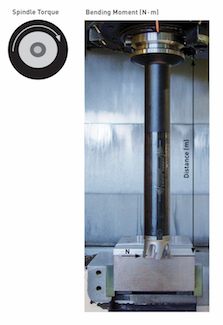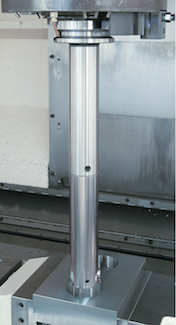Why Machinists Should Take Bending Moment As Seriously As Vibration
Slowing down to what seems like a safe speed may not be enough to prevent damage to a spindle or tool, especially a fine boring tool. Different than cutting torque, bending moment can greatly affect machining performance. First in a two-part series.
Posted: June 15, 2020
DEPTH OF CUT COLUMN
BY JACK KERLIN
If you’re looking for literature on the physics of cutting tool forces in 2020, chances are you won’t have to look far. Countless articles, whitepapers, and textbooks have been written on the subject. That’s not to say it isn’t great reading; everyone who cuts metal for a living should have a basic understanding of how speeds, feeds, and stock affect cutting forces. Any young person starting out in this industry should take some time to read up on it – if not to help them become a better machinist, then for fun. But the fact of the matter is, this stuff isn’t new. It’s been discussed and repackaged for years ad nauseam.
Noticeably missing from much of this literature is any mention of tool length besides the obvious “go slower as the tool gets longer.” It’s difficult to say whether that’s because there’s too much variation between tool length, shape, and material to properly quantify anything or because many see it as negligible. But many machinists don’t consider length, beyond slowing down, when looking at cutting forces, or they’re simply unfamiliar with the concept. Which is a shame, because this concept combines both tool length and cutting force, known as bending moment, which factors greatly into spindle/tool life and can even be used to somewhat predict operations that will damage your spindle or tool, visibly or invisibly.
The Difference Between Torque and Bending Moment
Slowing down to what seems like a safe speed may not be enough to prevent damage from an unsafe bending moment. What’s interesting is that little information exists regarding this less well-known and even less well-understood phenomenon, at least when it comes to machine tools, despite how it can affect machining performance.
What is bending moment? Despite the name, it has nothing to do with time. A moment is a force applied over a distance. Most of the general population, car enthusiasts especially, are familiar with torque; and bending moment operates under the same principle. The difference between the two mostly comes down to the situation and semantics.
Torque is typically used to describe a force that’s twisting a shaft or rotating body – the distance being the radius of the shaft/body – whereas bending moment is more general. It usually describes a force acting on the end of an unsupported beam, causing it to bend like a diving board. Both are examples of force applied at a distance and both behave according to the law of the lever.
Anyone who’s used a cheater bar to loosen a stubborn bolt understands the mechanical advantage of this law. Gears, pulleys, and driveshafts are just a series of levers arranged in a circle, with a force acting on the very end. It’s the same thing, just a different axis. In a literal sense, a moment is a force multiplied by the distance from some center of rotation, which is why the units work out to foot-pounds (ft lb) or Newton-meter (N⋅m).
In the world of machining, torque generally refers to the cutting force acting on the edge of the tool. Again, the radius of the tool is the distance here. Basically, it’s how much force the spindle motor must apply to turn the tool mid-cut – or, if you prefer, how much resistance the spindle motor encounters when trying to twist the tool.
Bending moment, on the other hand, is the side load or radial force that resists the tool as it moves position mid-cut. The distance would be the gage length. In other words, torque is more related to spindle speed, while bending moment has more to do with positional feed and material stock.
How Center of Gravity Affects All This
At some point, you may have read about moment of inertia in the automatic tool change (ATC) section of your machine manual. With every tool magazine, there is a limit to how much weight a tool pot can grip safely. There also is a moment limit, which considers the tool’s center of gravity as well as its weight.
Why do you need both limits? Because you can have two tools that weigh the same, but one has a center of gravity that’s farther from the supported end. The scale will read the same if you weigh the tools, but the leverage applied at the gripper will be much greater with one over the other. An example of this may be a short, stout angle head versus a long boring bar with a large head at the end. Both may weigh the same, but only one may rip itself free from the gripper.
It’s critical to distinguish between this bending moment and the bending moment produced by cutting forces, as we’re going to focus on the latter. Either satisfies the definition of bending moment, but the one we’re going to cover can seriously damage your spindle and tools. It’s also the one many machinists unknowingly overlook.
Bending Moment and Boring Tools
The consideration of bending moment is perhaps never more important than when dealing with a fine boring tool. These tools are characteristically long and encounter a radially unopposed load at the very end of their length. Boring bars are also slender, so by nature they’re a perfect lever to apply a bending moment. As a result, these tools are especially susceptible to failure if used incorrectly.
On the bright side, a boring bar will often break long before you apply enough cutting force to come close to damaging the spindle. However, the same can’t be said about a shell mill or milling chuck that’s thicker and shorter and experiences a substantially greater side load. In operations such as these, the tool may shriek like a banshee while cutting, but it won’t break. At first glance everything appears normal and you decide to reduce the feed on the next cycle. But upon closer inspection, you may find fretting or even bell-mouthing has already occurred on the spindle taper. Obviously, having to rebuild your spindle is a more serious problem than a broken tool, but this goes to show that bending moment is an issue to consider in any scenario.
If we treat a boring bar as a rigid cantilever beam supported at one end and cutting load as the applied force, it’s possible to determine the maximum bending moment: Simply multiply tool gage length by cutting force. This maximum will always be at the gage line because it’s the greatest distance from our “imaginary” axis of rotation.
Similarly, applying a force at the end of a wrench handle transforms it into a force amplifier, with the greatest rotational force, or torque, being at the bolt you’re tightening. The longer the wrench, the greater the torque; the longer the boring bar, the greater the bending moment.
Gage line is where the maximum rotational force is felt, so it’s a primary concern. That said, it’s not really where you should expect a tool to fail. Predicting that also comes down to things such as material composition and diameter, which tie back into what was mentioned before. A boring bar is slender enough to fail relatively easily. And based on the behavior of a cantilever beam, it will fail at its base, near where it’s being held. A short and stubby tool may be too thick for a moment to generate enough stress to physically deform it, in which case the tool will transmit the entire moment to the spindle taper, which will bear the brunt of the damage. This means that even though you’re at acceptable load levels and the tool hasn’t broken, you’re still harming your spindle.
Vibration, a topic that’s worthy of its own separate discussion, can be a symptom of a multitude of issues, some of them directly related to bending moment. It’s a common problem in machining, so most in the industry are familiar with it. Vibration doesn’t immediately or dramatically pose a risk to your machine (besides potentially scrapping a part), but over time it can inflict tens of thousands of dollars in repair damage. Machinists take vibration very seriously. Why isn’t bending moment, one of the potential causes of vibration, treated with the same respect?
Next month we give bending moment the respect it deserves.













